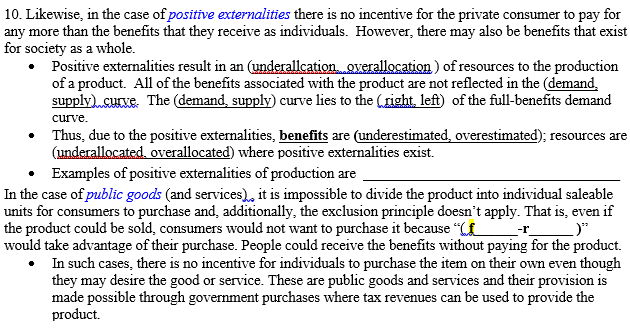10. Likewise, in the case of positive externalities there is no incentive for the private consumer to pay for any more than the benefits that they receive as individuals. However, there may also be benefits that exist for society as a whole. • Positive externalities result in an (underallcation. overallocation) of resources to the production of a product. All of the benefits associated with the product are not reflected in the (demand, supply) curve. The (demand, supply) curve lies to the (right, left) of the full-benefits demand curve. • Thus, due to the positive externalities, benefits are (underestimated, overestimated); resources are (underallocated, overallocated) where positive externalities exist. • Examples of positive externalities of production are In the case of public goods (and services), it is impossible to divide the product into individual saleable units for consumers to purchase and, additionally, the exclusion principle doesn't apply. That is, even if the product could be sold, consumers would not want to purchase it because "CE would take advantage of their purchase. People could receive the benefits without paying for the product. • In such cases, there is no incentive for individuals to purchase the item on their own even though they may desire the good or service. These are public goods and services and their provision is made possible through government purchases where tax revenues can be used to provide the product. --r_ _)"
10. Likewise, in the case of positive externalities there is no incentive for the private consumer to pay for any more than the benefits that they receive as individuals. However, there may also be benefits that exist for society as a whole. • Positive externalities result in an (underallcation. overallocation) of resources to the production of a product. All of the benefits associated with the product are not reflected in the (demand, supply) curve. The (demand, supply) curve lies to the (right, left) of the full-benefits demand curve. • Thus, due to the positive externalities, benefits are (underestimated, overestimated); resources are (underallocated, overallocated) where positive externalities exist. • Examples of positive externalities of production are In the case of public goods (and services), it is impossible to divide the product into individual saleable units for consumers to purchase and, additionally, the exclusion principle doesn't apply. That is, even if the product could be sold, consumers would not want to purchase it because "CE would take advantage of their purchase. People could receive the benefits without paying for the product. • In such cases, there is no incentive for individuals to purchase the item on their own even though they may desire the good or service. These are public goods and services and their provision is made possible through government purchases where tax revenues can be used to provide the product. --r_ _)"
Principles of Microeconomics
7th Edition
ISBN:9781305156050
Author:N. Gregory Mankiw
Publisher:N. Gregory Mankiw
Chapter11: Public Goods And Common Resources
Section: Chapter Questions
Problem 2PA
Related questions
Question

Transcribed Image Text:10. Likewise, in the case of positive externalities there is no incentive for the private consumer to pay for
any more than the benefits that they receive as individuals. However, there may also be benefits that exist
for society as a whole.
• Positive externalities result in an (underallcation. overallocation) of resources to the production
of a product. All of the benefits associated with the product are not reflected in the (demand,
supply) curve. The (demand, supply) curve lies to the (right, left) of the full-benefits demand
curve.
• Thus, due to the positive externalities, benefits are (underestimated, overestimated); resources are
(underallocated, overallocated) where positive externalities exist.
• Examples of positive externalities of production are
In the case of public goods (and services), it is impossible to divide the product into individual saleable
units for consumers to purchase and, additionally, the exclusion principle doesn't apply. That is, even if
the product could be sold, consumers would not want to purchase it because "CE
would take advantage of their purchase. People could receive the benefits without paying for the product.
• In such cases, there is no incentive for individuals to purchase the item on their own even though
they may desire the good or service. These are public goods and services and their provision is
made possible through government purchases where tax revenues can be used to provide the
product.
--r_
_)"
Expert Solution
This question has been solved!
Explore an expertly crafted, step-by-step solution for a thorough understanding of key concepts.
This is a popular solution!
Trending now
This is a popular solution!
Step by step
Solved in 3 steps

Recommended textbooks for you

Principles of Microeconomics
Economics
ISBN:
9781305156050
Author:
N. Gregory Mankiw
Publisher:
Cengage Learning

Principles of Microeconomics (MindTap Course List)
Economics
ISBN:
9781305971493
Author:
N. Gregory Mankiw
Publisher:
Cengage Learning

Principles of Economics (MindTap Course List)
Economics
ISBN:
9781305585126
Author:
N. Gregory Mankiw
Publisher:
Cengage Learning

Principles of Microeconomics
Economics
ISBN:
9781305156050
Author:
N. Gregory Mankiw
Publisher:
Cengage Learning

Principles of Microeconomics (MindTap Course List)
Economics
ISBN:
9781305971493
Author:
N. Gregory Mankiw
Publisher:
Cengage Learning

Principles of Economics (MindTap Course List)
Economics
ISBN:
9781305585126
Author:
N. Gregory Mankiw
Publisher:
Cengage Learning

Principles of Economics, 7th Edition (MindTap Cou…
Economics
ISBN:
9781285165875
Author:
N. Gregory Mankiw
Publisher:
Cengage Learning

Essentials of Economics (MindTap Course List)
Economics
ISBN:
9781337091992
Author:
N. Gregory Mankiw
Publisher:
Cengage Learning

Principles of Economics 2e
Economics
ISBN:
9781947172364
Author:
Steven A. Greenlaw; David Shapiro
Publisher:
OpenStax